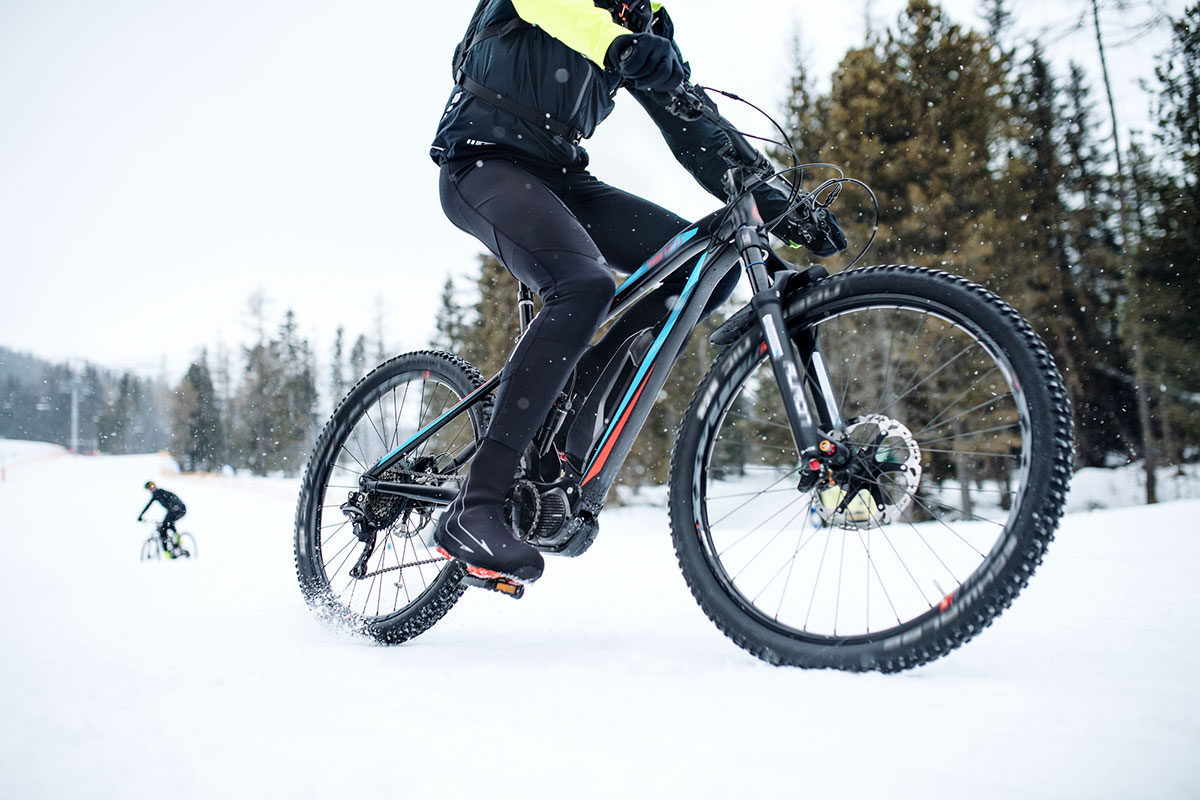
What do you do with your electric bike when temperatures plummet? If you’re like some who think that it is impossible to ride in snowy conditions, you probably garage your bike.
What if I told you, with some accommodation, it’s possible to turn your E-Bike into the perfect snow rider? Would you believe me? Keep reading to learn how.
Can I Use My Specific E-Bike During the Winter?

Certain e-bikes work better in the snow. A lot depends on how much snow your area gets.
Personally, I do not recommend front hub motorbikes for those who live in snowy areas. They are more prone to losing traction than other types.
The motor’s location influences your bike’s center of gravity. This affects how your bike handles slick surfaces.
Mid-drive motors are my bike of choice. Not only do they have a great center of gravity, but they also produce more torque. This feature comes in real handy in the snow.
Benefits of Fat Tires in the Winter

The size of your tires plays a huge role in effective riding in the snow. Your bike’s tires are the only things that connect it to the ground. So the proper set is vital.
Fat, knobby tires are the best because they have a larger contact patch and provide more grip. According to Shape.com, “The extra width gives you better traction, deeper grooves increase surface area for better ground grab, and less pressure lets you glide on top of the snow rather than sink into it.”
Furthermore, skinny tires often crack in icy conditions. In other words, fat tires are safer by sheer thickness. Their size also offers all-purpose functionality and improved stability.
Tony Babin from the Calgary Herald says, “Those big tires with low air pressure feel almost magically stable in snow, and, in most cases, on ice. Sure, they can slip, just like every other tire, but there is so much rubber grabbing the earth that the usual winter tentativeness vanishes.” Additional benefits include:
- More width: Fat tires have more contact surface. This lets them provide better traction in many riding conditions. This includes snow and ice but also the beach as well.
- More comfort: Fat tires absorb the bumps and shocks of rough terrain better. This makes them more comfortable riding in unpredictable terrain.
- More utility: You can safely depressurize your fat tires to 15 or 20 psi. These low pressures are actually better for icy conditions.
Important Features to Consider When Getting New Fat Tires for Your E-Bike
Riders in Alaska assembled the first fat tires. They wanted a tire that let their vehicles float over snow. It also had to have good traction on slippery surfaces. They found their answer in fatter tires.
Since then, the field has evolved. There are some features to consider when choosing the type for you:
- Versatility: Make sure you get winter, and not rain, tires. Winter tires cost more but they offer the benefits you’ll need to enjoy your bike during the cold season.
- Studs: If you live somewhere that gets snow at least 4 weeks a year, studs are a great idea. They provide improved stability in particularly icy conditions, even on very compacted snow.
- Width: The general rule of thumb is, the wider the tire, the better its wintertime performance. This is because it increases the tire’s contact surface area. There are several tires that advertise themselves as fat. But, remember a 4-inch tire gets more surface area than a 3 inch one.
Special Tips and Considerations

Riding your bike during the winter isn’t the same as doing so during the summer. The snow changes things, including the terrain and slickness of the road.
It’s important to take precautions to ensure a safe and great ride. Thankfully, most of this is common sense and doesn’t require a higher riding skill. My top tips include:
Take things slow: Quick stops, starts, and other sudden movements are not good for your tires. They increase the force on its contact patch. This also increases your chances of skidding.
Try Not to Pedal
The best winter riding tip is to take advantage of your bike’s electric abilities. Try not to pedal and just let your bike roll over the snow at a slow speed. If you must pedal, use a lower power level and gear.
Take Some Air Out of Your Tires
Reducing the tire pressure helps improve its grip in winter conditions. You get 50% better traction and stability by reducing the recommended tire pressure. This depends on the specific situation. If you’re riding in very hard-packed conditions, this may be too much. Fat tires, in particular, can go down to 10 or 15 psi safely.
Combine Your Fat Tires With a Battery Pack

Has your smartphone ever lost power when it was cold outside? The last time you looked at your phone, it was fine. But, just a couple hours later, your phone was kaput?
Cold conditions have a deleterious effect on battery life. This is true for e-bike batteries too.
In this case, you’ll want to pair your bike’s electrical charge with a large battery and case. The bigger size doesn’t make it more resistant to the winter weather. But, it lets your battery hold a longer charge. This will ensure you have juice for each ride you take.
If you consider the tips and suggestions in this guide, I predict you’ll love winter riding as much as I do. Good luck!
Sources:
